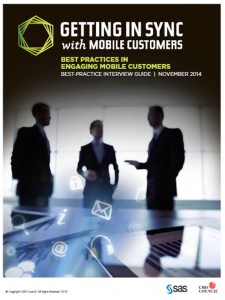Few advances in technology have impacted how we do business as broadly and profoundly as mobile. Mobile devices are changing how people behave and what they expect, and as a result it’s changing the way we need to engage with our customers.
The way consumers become emotionally attached to their mobile devices makes it increasingly important to get it right when engaging with them. Mobile - especially interactive devices such as smartphones and tablets – are digital, search and social all rolled into one, making them far more than just another channel. As a result, it requires new thinking, new platforms and new talent to address customer expectations for relevance and immediacy across all channels.
 These developments and their impact on marketing motivated us to partner recently with the CMO Council to conduct research on how organizations are getting in sync with their mobile customers. Part of that research was a series of interviews conducted with executives from AIG, Cisco, Dell, The Home Depot, Marriott International, Men’s Wearhouse, TripAdvisor, Wells Fargo, and Western Union.
These developments and their impact on marketing motivated us to partner recently with the CMO Council to conduct research on how organizations are getting in sync with their mobile customers. Part of that research was a series of interviews conducted with executives from AIG, Cisco, Dell, The Home Depot, Marriott International, Men’s Wearhouse, TripAdvisor, Wells Fargo, and Western Union.
These executive interviews revealed emerging mobile best practices that I will synthesize and examine each Friday over the next few weeks. Beginning with today's look at mobile marketing objectives and context, we'll continue with the following perspectives:
- Challenges and success metrics
- Engagement and the customer experience
- The importance of the mobile-first attitude and alignment
The opportunity with mobile for marketers is to tailor customer experiences that meet expectations and to fulfill our organizational purpose like never before. And mobile is digital in nature, so it generates streams of data with great potential waiting to be unlocked with marketing analytics to learn not simply what customers want, but also how, when and where they want it.
In terms of objective for mobile marketing, most of these leading firms strive to ensure that any information that could help customer better understand products and services is accessible from any device. Cisco, for example, has designed its support website around a dynamic, mobile, user-friendly interface so that customers can ask a question and receive an immediate answer. At AIG, in the U.K., they have already started to create separate experiences based on the device being used, but the ultimate goal is to create a seamless customer journey, regardless of device. The objective at Wells Fargo is similar in that its mobile strategy revolves around the company’s mission to be there for the customer whenever and wherever they are and via whatever device they use.
All this happens in a context in which mobile and social media are intertwined – precisely because that’s exactly how our customers see them. Marriott has already noticed changes in customers’ behaviors and expectations, particular in terms of seeking peer-to-peer networking and mobile interactions with guests while they are on-site at their properties. The dynamic for Wells Fargo is slightly different, with a dramatic increase in mobile traffic in the past year, while still needing to accommodate customers that may not be comfortable with transactions over mobile devices.
Our next look at mobile best practices will be to examine the challenges these organizations face and how they approach measures of success. Until then, you are welcome to download the full CMO Council report, Getting in Sync with Mobile Customers: Best Practices in Engaging Mobile Customers.
As always, thank you for following!
